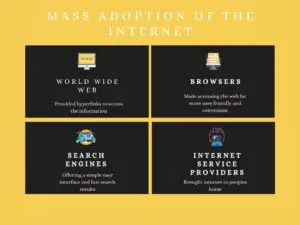A Beginners Guide to Decentralized Internet
Internet founders envisioned it as a decentralized entity. However, internet traffic has shifted to a handful of websites over the years. Ahrefs.com reports that most global internet traffic is directed to a handful of websites. YouTube, Facebook, and Amazon are the biggest beneficiaries.
These mega-corporations have made internet users dependent. For example, Facebook, Amazon, and Google are all used for communication.
Have questions about how this decentralized Internet was centralized?
For more information, please read on.
From decentralized to central
Anyone can access complete information via the Internet from anywhere. To do this, all you need is an Internet connection.
The Internet can be used to do almost everything, including shopping, ordering groceries, and paying bills. Even from your home, you can join a safari. Everybody needs the Internet. It can cause havoc in the world if the Internet is down for more than a few seconds.
However, this growth comes at the cost of the Internet losing its centrality. It used to be possible to publish anything online without any dependence on third-party services providers. With equal opportunities, everyone had access to the Internet.
Although it is true that not everyone still controls a significant portion of the internet infrastructure that connects us all to the world wide web, it is also true that nobody owns the entire network. Companies like Amazon, Google, and Facebook have seized a significant portion of the internet traffic by providing simple-to-use platforms and innovative ideas.
Few tech companies are now the dominant force on the Internet with their services. These tech companies have monopolized their industry for years. They have control over what information can be accessed via the Internet.
Mass Adoption of the Internet
Few websites are dominating the web because of the mass adoption of the Internet.
The earliest version of the Internet was invented by the US Department of Defense (DoD). The Internet was created by the US Department of Defense (DoD) to allow computer communication in times of war or disaster. In addition, the Internet was created to be decentralized so that information can still be accessed even if one component of the network is down.
Later many institutions and organizations contributed to making the Internet what it is today.

These inventions were key to the mass adoption of the Internet.
1. World Wide Web
The Internet was forever changed by Tim Berners-Lee’s invention of the web and HTML. Users can now access the sites via the hyperlinks provided.
2. Browsers
The entire system was first known as the World Wide Web (WWW). This is why you have to use the “www” prefix before entering the domain name that you want to visit.
Internet became a reality thanks to the development of browsers. Accessing the Internet was made easier and more user-friendly by the advent of browsers.
Microsoft’s 1995 launch of Internet Explorer accelerated the use and popularity of the Internet. Many browsers were later developed that made it easy to access the Internet.
3. Search Engines
Many websites were created as the Internet gained popularity. Therefore, it was inevitable that search engines would need to index all websites.
Yahoo is just one of many web-searching and indexing systems that have been created. Google, however, is the market leader in search. This is because it only emerged in the late 1990s.
Google’s simple interface and quick search results made it extremely popular. As a result, Google is often used as an alternative verb for Internet search by many people.
4. Internet Service Providers
The Internet was now ready to be adopted by mass. Therefore, only the service providers that can bring the Internet into people’s homes were needed. Thus, Internet Service Providers (ISPs) were born.
Internet service providers began providing internet services over dial-up modems with data speeds of between 14 and 28 kbps. Data speeds are now reaching 100 Mbps thanks to technological advances.
Internet Advertising
Internet connections became stable as ISPs were created. Many companies started to use the Internet, and many internet applications were created. This was the moment when web 1.0 was born.
Microsoft played an important role in the growth of internet usage and commercialization. All this started with the introduction of Internet Explorer, built into Windows 95. Thus, Microsoft introduced the Internet for many users who were first using it.
I was also introduced to the Internet via Internet Explorer and Windows 95. I can still recall those early days when the Internet was not what it is today. Similar to me, the Internet has also impacted many others.
Slowly but surely, the Internet grew as more users joined. This led to a lot of information being shared online. This boosted the Internet’s commercial aspect.
With commercialization came the time for centralization.
The Internet became more economically viable. Many new platforms allowed users to search, shop, and communicate online.
This was the birthplace of Web 2.0. The web user interface was easy to use, and users could access it from different devices.
Innovative ideas were developed by many companies, including Google, Amazon, and Facebook. They offered services that helped them to dominate the Internet.
These companies have become so large over the years that they now have the most user’s attention. Data is often referred to today as modern-day oil. It is continuously harvested. The data is then sold to third parties companies, providing them with an advertising platform.
These companies have grown so large because they provide platforms that meet users’ needs. It is almost impossible for new entrants to compete with these companies because they are so large. In addition, they have so much control over what users see and cannot see.
Facebook acquired many small businesses like Oculus, WhatsApp, Instagram, and WhatsApp to grow its reach. As a result, a variety of services are offered, from social media platforms to VR-enabled devices. Unfortunately, it isn’t easy to find someone who has not used any of the Facebook products.
Google also acquired many platforms over time that have made it a huge platform that offers many services. Google offers many services, including Gmail, Google Maps, and Gdrive. Nearly everyone has access to the Internet and uses some Google service.
These platforms have accessed an immense amount of user data. These data can be anything from your location to what you would like to see.
Other platforms such as Amazon, Twitter, and Snapchat dominate different demographics.
As a result, internet centralization was limited to a few service providers. _
The question is: What is wrong with centralized internet access? If we have stable internet access and are receiving top-quality services, then it is safe.
What’s the problem with the central Internet?
A centralized system can be defined as one that has concentrated power and authority. It might be a surprise to you that the Internet can still be used to create your website and publish what you want.
You can. You won’t get any traffic to your site if Google does not index your website. It would help if you also were active on Facebook. This is where everything gets centralized.
The dominance of Google and Facebook also led to behavioral changes in how people access information. For example, users would visit their favorite news site or blog to find out the news in the past. Now things are different.
Most people use Twitter and other social media platforms such as Facebook and WhatsApp to get news and information.
Facebook has 2.70 Billion monthly active users, and 3.14 Billion users are active on other Facebook-owned sites.
Google, the most popular search engine, processes approximately 5.8 billion queries per day. As a result, Google is the most popular search engine that people use to find information.
The result is that power has been concentrated in the hands of a few who are the gatekeepers to the information users have access to
Similar Fact: Facebook tried to offer free internet service to India’s first-time users. This was to convince them that Facebook is the Internet.
Data Leaks and Misuse
Users are giving these platforms access and allowing them to access a lot of their data. For example, they can see where you ate or watched a film. They also know your birthdays, anniversaries, and other information. In addition, third-party companies can harvest data that could be used to display ads for you.

Each Internet company uses a central system that stores all information in their data centers. Therefore, data breaching is a serious threat to these centralized data centers.
Recent data breaches at Facebook led to the release of personal information by hackers. This affected 530 million Facebook users. Nearly every month, there are news stories about data breaches or data being sold to the dark web.
Hackers have one target when they access centralized data storage. These centralized data centers of large tech companies are vulnerable to DDoS attacks.
Big tech companies and third-party advertisers can also use user data to manipulate people. In some cases, election manipulation has been done by targeting voters with ads that influence their votes.
The government has also used the data to spy on citizens and political dissenters.
Fear of Single Point Failure
Data management and storage are easier with centralized architectures. However, centralized data centers can cause one point of failure. Hacker attacks and technical problems can cause a system failure.
Every day there is news about outages to services. For example, many websites hosted on Amazon web services will go down when a central service like Amazon Web Services goes down.
Similar issues can also cause Gmail, YouTube, and Gdrive to be unavailable due to problems with Google servers.
In addition, many single-point failures have been reported. This causes people to suffer from a global outage caused by a technical glitch at one of the data centers.
It might seem that you are thinking this, even though what we currently use is a centralized Internet. So what is a decentralized Internet? How can it be achieved?
What is Decentralized Internet?
As you may have guessed from the name, decentralized Internet is an Internet system without a single owner. Instead, a decentralized internet would have multiple owners who will keep a copy of the information that users can access.
Although it is possible for the Internet to crash, decentralized Internet will not cause an outage like a centralized internet. Because data is distributed across many locations, users can access it even if one or more servers fail. It works similarly to peer-to-peer sharing, where multiple users share the same data.
Another example of a decentralized system that can be used is cryptocurrency. Everybody is talking about Bitcoins, Dogecoin, or some other new entrant. Even if you don’t like cryptocurrency, the system underlies it, which is blockchain, must interest you.
Blockchain technology is what will allow us to make the Internet more decentralized. Experts suggest that a peer-to-peer internet network be built. The system is controlled by the community and not a single Internet Service Provider.
Decentralized systems will allow users to access the Internet through hundreds of access points. Blockchain is the only way to make this a reality. Blockchain is the core concept behind Web 3.0.
Web 3.0
Websites were static HTML websites when the Internet was created. These websites are known as Web 1.0. Web 2.0 was the next evolution of the Internet, which led to dynamic websites that users can control. Web 2.0 has led to the rise of social media and companies such as Amazon, Google, and Facebook.
Although Web 3.0 definition is still in flux, it will be based on peer-to-peer technology such as blockchain. In addition, web 3.0 attempts to return the Internet to its original state, where users had full control of what they posted—a web where there are no ISPs that control what you see and no single point for failure.
Web 3.0 is designed to get rid of constant surveillance and targeted ads, as well as the central tech giants who control large swathes of the Internet. Instead, users will be able to control their data and decide who has access to it.
Web 3.0 will be operated without any centralized servers, making it safe and free from a single point of failure.
The Benefits of Decentralized Web
There are many benefits to the Decentralized Internet. These are just a few.
1.Secure
Decentralized internet networks are, without a doubt, the most secure. This is because your data will be protected using blockchain technology. To validate data in the blockchain, the data must be from adjacent blocks. This means that high-level encryption is difficult to crack.
2.Censorship
The decentralized Internet is less judgmental than the centralized one. The current system allows service providers to choose what information they present to users. As a result, it will be less vulnerable to government censorship or tech companies’ censorship because there is no central authority.
3. Simple browsing
Web 3.0 can dramatically improve web browsing through a decentralized system that provides a more user-friendly experience. Users will be able to filter the search results that have been manipulated using an AI-enabled algorithm. As a result, users get the most relevant information.
4.Data cannot be changed
Blockchain technology eliminates the possibility of data being altered or deleted without authorization. The blockchain stores all records of any changes, even those made by authorized persons.
5. No Central Point of Control
Data is no longer stored on centralized servers that could be damaged or DoS attacks from hackers. It would be nearly impossible to stop information from flowing freely because there are multiple ways to access it.
The Future
Web 3.0 is a promising future as global internet connectivity continues to grow. Blockchain-based Internet has increased in likelihood. The Internet will become truly decentralized in the future, just as it was back when it was invented.
The future is free Internet without a few tech giants. Web 3.0 will create a level playing field and allow users to control their content, not ISPs or tech companies.
As it becomes mainstream, the decentralized Internet will face challenges. However, once the Internet is mainstreamed, users will regain full control over their data and identities.
Conclusion
The Internet’s growth was aided by innovative services offered by ISPs and tech giants such as Google and Facebook. However, governments and tech service providers have taken control of the Internet and put power in the hands of a few.
These problems can be addressed by a decentralized internet that uses blockchain. Decentralized Web 3.0 promises secure internet connections and information flow without censorship.




